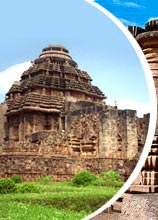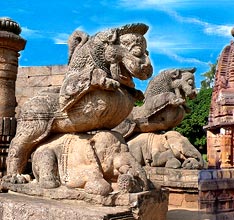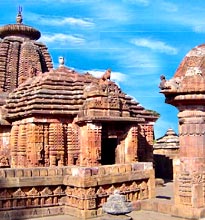Orissa has a glorious and ancient history spanning a period of over 2000 years. In ancient times, it was the proud kingdom of Kalinga. Kalinga was a major seafaring nation that controlled most of the sea routes in the Bay of Bengal. For several centuries, a substantial part of Southeast Asia, such as Kampuchea (Cambodia), Java, Sumatra, Bali and Thailand were colonies of Orissa. In fact the name of the country "Siam" is derived from Oriya/Sanskrit Shyamadesha. The temple of Angkor Wat is a fine example of Orissan architecture, with some local variations. Bali still retains its Hindu Orissan heritage. A major turning point in world history took place in Orissa. The famous Kalinga war that led emperor Asoka to embrace non-violence and the teachings of Buddha was fought here in 261 BC. Later on, Asoka was instrumental in spreading Buddhist philosophy all over Asia. In the second century BC, Kalinga flourished as a powerful kingdom under Kharavela. It is he who was built the superb monastic caves at Udayagiri and Khandagiri.Subsequently, the kingdom was ruled under various monarchs, such as Samudragupta and Sasanka. It also was a part of Harsha's empire. In 795 AD, the king Yayati united Kalinga, Kosala and Utkala into a single empire. He also built the famous Jagannath temple at Puri. King Narasimha Dev is reputed to have built the magnificent sun temple in Konark. Although now largely in ruins, the temple would easily have rivaled the Taj Mahal in splendor. The ruins of a major ancient university and center of Buddhist learning, Ratnagiri, was recently discovered in Orissa. Scholars from far away lands, such as Greece, Persia and China used to study philosophy, astronomy, mathematics and science at this famed University. Taxila, Nalanda and Ratnagiri are the oldest universities in the world. The ruins of Ratnagiri University have not been fully excavated yet. During the dark ages of Indian civilization, Orissa was ruled by a succession of Muslim kings. It was later annexed by emperor Akbar and became part of the Mughal empire. After the fall of the Mughals, the Marathas under Shivaji invaded the land and continued to rule until 1803 AD when Orissa fell prey to the barbaric British. Modern Orissa was carved out of Bihar in 1936. Contemporary Orissa has a proud cultural heritage that arose due to the intermingling of three great religious traditions - Hinduism, Buddhism and Jainism. It has been further enriched by Islam and Christianity. ART HERITAGE OF ORISSAOrissa has witnessed ceaseless human endeavour in the field of art, craft, sculpture and temple building activities for about 2500 years during her recorded history. Endowed with nature’s beauty and bounty, Orissa boasts of a rich cultural heritage and tradition of music, dance, dramatics, art & crafts of many splendoured varieties and forms; which elegantly emanate from its magnificent monuments, ancient caves, rock-cut sculptures and innumerable temples found still intact with all its prestine glory and grandeur. This holy land with a hoary past, offers the quintessence of the multifaceted cultural profiles of Indian panorama. Art in all its myriad forms is so deeply ingrained in this state that the routine chores of the folk styles take sublime aesthetic expression of magnificent diction in intangible performing art idioms Prehistoric & Protohistoric: The wooded hinterland of the state beyond Eastern Ghats is the store house of earliest rock paintings. At Ushakothi and Manikmunda in Sundargarh district, Bikramkhol in Jharsuguda district and Gudahandi and Yogimath in Kalahandi, there are upper Paleolithic rock paintings (in red ochre or Hematite) and rock bruising. The painting on the facade of a cave at Gudahandi is exuberantly realistic. The hunting scene of a man throwing a stone missile at a running bison is of high artistic excellence. Maurya, Meghavahana and Gupta Art tradition: The history of Orissan art and architecture is corelated with her early history which starts from 261 B.C., when Ashok conqured Orissa, then known as Kalinga. The earliest specimen of Orissan art is the colossal figure of the foreport of an elephant carved on the top of the boulder containing Ashoka’s edicts at Dhauli about five miles from Bhubaneswar. There was also an Ashokan pillar now enshrined inside Bhaskareswar temple in Bhubaneswar which has been converted into a Shivalingam later on. These Ashokan monuments thus marked the beginning of Orissan art and architecture. The magnificent specimen of Orissan secular monuments of the pre-Christian epoch is provided by Sisupalgarh, situated about a mile to the east of Bhubaneswar. The ruins of this ancient fort represent a well planned and well-fortified city. The excavations carried on here by the ASI during the years from 1947 to 1949, unearthed some antiquities which take the origin of the city back to the fourth century B.C. The next stage of the development of Orissan art and architecture is marked by the caves of Udayagiri and Khandagiri which stand side by side about five miles to the west ofBhubaneswar. These hillocks have been honey-combed with rock-cut caves meant for Jaina ascetics. The graphic account of emperor Kharavela’s reign and campaigns of 1st century B.C. are found in the Hatigumpha inscription of the Udayagiri hill. The grand and excellent art and architecture of these caves bear base-reliefs which depict the Jaina pantheons and objects of devotion, panoramic views of the worship of the sacred tree or symbols. The sculptures carved out in these caves are specimens of fine artistic excellence marked by vigour and simplicity and share characteristics in terms of antiquity with the sculptures of Bharhut, Sanchi and Bodhagaya. The political history of the period following emperor Kharavela is described as the dark period of the Orissan history. The Naga and Yakshya images discovered in Bhubaneswar and presented in the Orissa State Museum can however be assigned to this dark period. They are similar to the Naga and Yakshya images found at Sanchi, Mathura and Rajgir and can safely be placed in the 1st or 2nd century A.D. Evidently there were Stupas in Bhubaneswar of which these images are the survivals. They also indicate that the Naga and Yaksha worship was popular in Orissa after the fall of Kharavela’s dynasty, when Jainism appears to have received a setback. It is still a disputed point whether the Gupta’s ever held their direct sway over Orissa, but the classical Gupta age did not fail to spread its influence over the Orissan monuments. Several images have of late been discovered, which bear the Gupta characteristics. One very definite specimen of Gupta art in Orissa is a mural painting found at Sitabhinji in the Keonjhar district, which depicts a royal procession with a line of writing below the scene, recording the name of the Bhanja king ‘Disabhanja’ which is palaeographically assigned to 4th & 5th century A.D. No Gupta temple has yet been discovered in Orissa, but the earliest Orissan temples definitely bear the Post-Gupta influences both in respect of art and architecture. There are a very large number of sculptural and architectural specimens found at cultural centres of Orissa like Puri, Bhubaneswar and Jajpur and these probably belonged to the temples no longer in existence. These remnants provide an interesting study which, when pursued is likely to bridge the gap of the so-called Dark Period. Buddhist Architecture: Architecture and sculpture made notable progress in the medieval period under the patronage of Sailadbhavas, Bhaumakaras, Somovansis and the Gangas. The development of different religions was the basis of such abundant output of art. The best specimens of Buddhist art are found at Puspagiri, Udayagiri, Lalitagiri, Solanpur, Khadipada, Ayodhya, Khiching, Kuruma, Boudh, Banpur and other places. Perhaps, the finest establishment of the Buddhism was at Ratnagiri in Cuttack district. Excavations have revealed the remains of a magnificent main Stupa, two spacious Viharas, several votive Stupas and numerous Buddhist sculptures of great artistic excellence. The figures of Boddhisatwas discovered from Lalitagiri and Langudi are distinguished by unsurpassed grace and slender suppleness. Achutarajpur (near Banpur) in Khurdha district has yielded the largest hoard of Buddhist bronze images of exquisite workmanship. Noteworthy among these bronze images arerepresentation of Buddha, Tara, Trailokyavijaya etc. Recent excavation in Langudi hill has brought to light a huge Buddhist structure alongwith two Asokan statues with inscription. |
Friday, 2025-07-11, 3:30 AM
Alll about Orissa
|
|
Trace ME
Site menu
Weather
CUTTACK PURI SAMBALPUR BERHAMPUR Join 2 the world
SOCIAL SPARK
Our poll
Statistics
Total online: 1 Guests: 1 Users: 0 |



